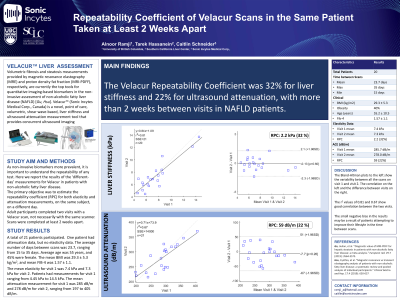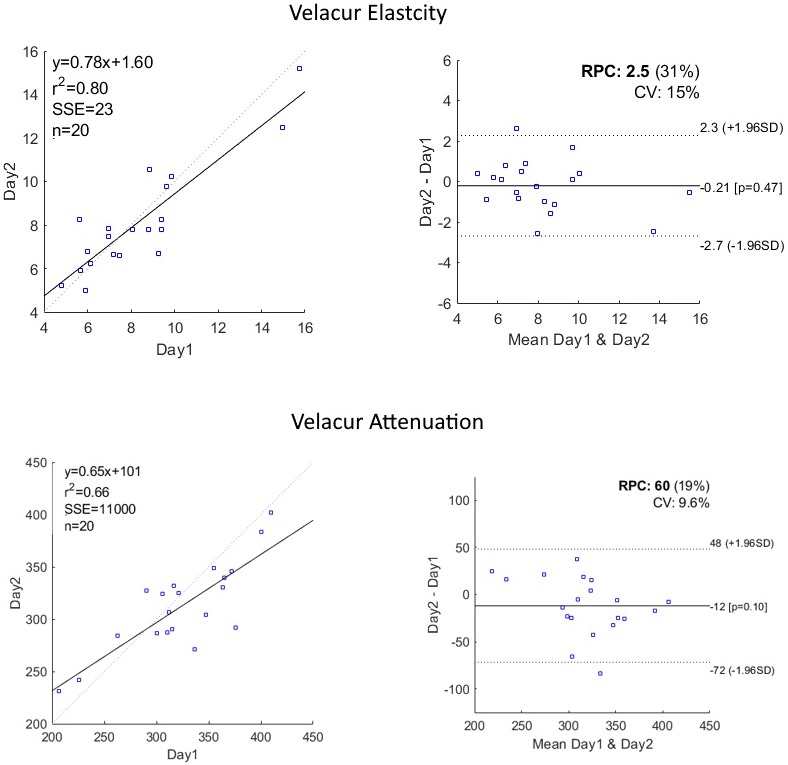Monday Poster Session
Category: Liver
P2401 - Repeatability Coefficient of Velacur Scans in the Same Patient Taken at Least 2 Weeks Apart
Monday, October 23, 2023
10:30 AM - 4:15 PM PT
Location: Exhibit Hall

Has Audio
- AR
Alnoor Ramji, MD
Gastrointestinal Research Institute
Vancouver, British Columbia, Canada
Presenting Author(s)
Alnoor Ramji, MD1, Caitlin Schneider, PhD2, Tarek Hassanein, MD3
1Gastrointestinal Research Institute, Vancouver, BC, Canada; 2Sonic Incytes Medical Corp, Vancouver, BC, Canada; 3Southern California Transplantation Institute Research Foundation, Coronado, CA
Introduction: As non-invasive biomarkers become the standard of care for diagnosis and monitoring of patients with chronic liver disease, it is important to understand the repeatability of any test. Here we report the results of the ‘different-day’ measurements for Velacur elasticity and attenuation in patients with non-alcoholic fatty liver disease.
Methods: As part of protocol for a clinical study, adult participants were asked to complete an additional optional visit with a repeated Velacur scan. All scans were completed by a qualified Velacur scanner, but the repeated scans were not always completed by the same scanner. Exams were collected at two sites, in Vancouver, BC and in Coronado, CA.
Between 5 and 10 volume measurements were completed during each visit as per protocol and the median of these measurements was used as the exam result for this analysis.
The primary objective was to estimate the repeatability coefficient (RPC) for both elasticity and attenuation measurements, on the same subject, on a different day. Scans were completed at least 2 weeks apart.
Results: A total of 20 subjects with clinically confirmed non-alcoholic fatty liver disease were included in this analysis Velacur scan repeatability. The average number of days between scans was 24.8, ranging from 15 to 37 days. Average age for these patients was 57 years, and 52% were female. The mean BMI was 29.9 +/- 5.8 kg/m2, and mean FIB-4 was 1.72 +/- 1.05.
The mean elasticity for visit 1 was 8.3 kPa and 8.1 kPa for visit 2. Patients represented the full spectrum of disease with stiffness with measurements for visit 1 ranging from 4.8 kPa to 15.2 kPa. The mean attenuation measurement for visit 1 was 324 dB/m and 313 dB/m for visit 2, ranging from 206 to 402 dB/m.
The RCP for elasticity was 31% and for attenuation was 19%.
Discussion: The repeatability coefficients are important to be able to understand what a true change might constitute, rather than differences attributable to measurement error. The results measured here were taken further apart than during other similar studies (measured 7 days apart), so might also incorporate some real changes in the patient disease state. The results are the first step in understanding the repeatability of Velacur measurements in a NAFLD/NASH patient population.

Disclosures:
Alnoor Ramji, MD1, Caitlin Schneider, PhD2, Tarek Hassanein, MD3. P2401 - Repeatability Coefficient of Velacur Scans in the Same Patient Taken at Least 2 Weeks Apart, ACG 2023 Annual Scientific Meeting Abstracts. Vancouver, BC, Canada: American College of Gastroenterology.
1Gastrointestinal Research Institute, Vancouver, BC, Canada; 2Sonic Incytes Medical Corp, Vancouver, BC, Canada; 3Southern California Transplantation Institute Research Foundation, Coronado, CA
Introduction: As non-invasive biomarkers become the standard of care for diagnosis and monitoring of patients with chronic liver disease, it is important to understand the repeatability of any test. Here we report the results of the ‘different-day’ measurements for Velacur elasticity and attenuation in patients with non-alcoholic fatty liver disease.
Methods: As part of protocol for a clinical study, adult participants were asked to complete an additional optional visit with a repeated Velacur scan. All scans were completed by a qualified Velacur scanner, but the repeated scans were not always completed by the same scanner. Exams were collected at two sites, in Vancouver, BC and in Coronado, CA.
Between 5 and 10 volume measurements were completed during each visit as per protocol and the median of these measurements was used as the exam result for this analysis.
The primary objective was to estimate the repeatability coefficient (RPC) for both elasticity and attenuation measurements, on the same subject, on a different day. Scans were completed at least 2 weeks apart.
Results: A total of 20 subjects with clinically confirmed non-alcoholic fatty liver disease were included in this analysis Velacur scan repeatability. The average number of days between scans was 24.8, ranging from 15 to 37 days. Average age for these patients was 57 years, and 52% were female. The mean BMI was 29.9 +/- 5.8 kg/m2, and mean FIB-4 was 1.72 +/- 1.05.
The mean elasticity for visit 1 was 8.3 kPa and 8.1 kPa for visit 2. Patients represented the full spectrum of disease with stiffness with measurements for visit 1 ranging from 4.8 kPa to 15.2 kPa. The mean attenuation measurement for visit 1 was 324 dB/m and 313 dB/m for visit 2, ranging from 206 to 402 dB/m.
The RCP for elasticity was 31% and for attenuation was 19%.
Discussion: The repeatability coefficients are important to be able to understand what a true change might constitute, rather than differences attributable to measurement error. The results measured here were taken further apart than during other similar studies (measured 7 days apart), so might also incorporate some real changes in the patient disease state. The results are the first step in understanding the repeatability of Velacur measurements in a NAFLD/NASH patient population.

Figure: Correlation and Bland-Altman plots of Velacur elasticity and attenuation for measurements taken from the same patient, at least two weeks apart.
Disclosures:
Alnoor Ramji: Abbvie – Advisor or Review Panel Member, Grant/Research Support, Speakers Bureau. Amgen – Speakers Bureau. Gilead – Advisory Committee/Board Member, Consultant, Grant/Research Support, Speakers Bureau. Intercept – Advisory Committee/Board Member, Grant/Research Support, Speakers Bureau. Janssen – Grant/Research Support. Novartis – Grant/Research Support. Novo-Nordisc – Advisory Committee/Board Member, Grant/Research Support, Speakers Bureau. Pfizer – Grant/Research Support.
Caitlin Schneider: Sonic Incytes Medical Corp – Employee.
Tarek Hassanein: AbbVie – Advisor or Review Panel Member, Consultant, Grant/Research Support, Speakers Bureau. Allergan – Grant/Research Support. Amgen – Grant/Research Support. Assembly – Grant/Research Support. Astra Zeneca – Grant/Research Support. Biolinq – Grant/Research Support. Boehringer-Ingelheim – Grant/Research Support. Bristol-Myers Squibb – Advisor or Review Panel Member, Consultant, Grant/Research Support, Speakers Bureau. CARA – Grant/Research Support. Cytodyn – Grant/Research Support. DURECT Corporation – Grant/Research Support. Enanta – Grant/Research Support. Escient – Grant/Research Support. Galectin – Grant/Research Support. Gilead – Advisor or Review Panel Member, Consultant, Grant/Research Support, Speakers Bureau. Grifols – Grant/Research Support. HepQuant – Grant/Research Support. Intercept – Grant/Research Support. Janssen – Grant/Research Support. Mallinckrodt – Advisor or Review Panel Member, Consultant. Merck – Advisor or Review Panel Member, Consultant, Grant/Research Support. Mirum – Grant/Research Support. Novartis – Grant/Research Support. Novo Nordisk – Grant/Research Support. Nucorion – Grant/Research Support. Organovo – Advisor or Review Panel Member, Consultant. Pfizer – Grant/Research Support. Provepharm – Grant/Research Support. Regeneron – Grant/Research Support. Salix Pharmaceuticals – Grant/Research Support. Sonic Incytes – Grant/Research Support. Terns Pharmaceuticals – Grant/Research Support. Valeant – Grant/Research Support.
Alnoor Ramji, MD1, Caitlin Schneider, PhD2, Tarek Hassanein, MD3. P2401 - Repeatability Coefficient of Velacur Scans in the Same Patient Taken at Least 2 Weeks Apart, ACG 2023 Annual Scientific Meeting Abstracts. Vancouver, BC, Canada: American College of Gastroenterology.
